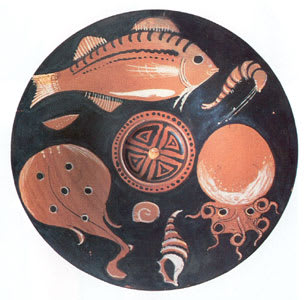Apulian Red-Figure Fish Plate, 400 BCE - 300 CE
Terracotta
7.78 x 7.78
PF.0844
A fish plate is a conventional name given to a Greek pottery vessel which was mostly used by Greeks of the West during the 4th century BC. Although the form...
A fish plate is a conventional name given to a Greek pottery vessel which was mostly used by Greeks of the West during the 4th century BC. Although the form as such was invented in 5th century BC Athens, most of the corpus of the surviving fish plates derive from Southern Italy, where 4th century BC Greek settlers, called "Italiotes," manufactured and used them. The form of the plate is generally known and called a "pinax" or "pinakion", meaning "tablet," because of its flat shape. The fish plate's form was that of a dimpled disk elevated on a pedestal, in other words, round and flat with a small cup in the center of plate designed to hold oil or sauce. Its rim was turned down, and often bears a decorative border, either spiraling waves, Greek key and meander motifs, or a wreath of laurel leaves. A fish plate is almost always also elevated above table level by a pedestal foot. Plates of this form are known since Minoan times but they were not decorated with fish until the end of the 5th century BC.
As mentioned above fish plates were first produced in Athens during the late 5th century BC. These Attic fish plates are characterized by fish whose lower part of the body is oriented towards the outside rim of the plate. In Athens the palette was restricted to red clay fabric and black gloss slip with rare uses of white overpainting. During a later period, Italiote Greek settlers of Southern Italy began to mass-produce more colorful fish plates in Taranto (Greek "Taras"), Paestum (Greek "Poseidonia"), Capua (Etruscan "Capue"), and Cumae (Greek "Kyme"). These South Italian fish plates are characterized by a decoration in which the fish's lower body is oriented towards the sauce cup at the center of the plate. The name "fish plate" derives also from the usual decoration of these plates which includes various fish and other marine creatures. Fishes depicted include bream, perch, torpedo fish, tuna, flying fish, puffer fish, scorpion fish, squid, cuttlefish, octopus, scallop, clam, dentalia, murex, sea snail, shrimp, crab, dolphin, hippocamp, etc. All fish plates are red figure ware, while the body of the vessel is largely painted in black glaze. Then dilute glaze and white overpainting were applied. Sometimes, in the South Italian examples the palette is enlarged to include deep red, pink, and yellow overpainting as well. This polychrome technique with its chiaroscuro is called "sovradipinto."
Some contend that fish plates were decorated with pictures of the seafood they were intended to hold. Most of them, however, have been found in mortuary contexts, so it might be surmised that the fish images could represent symbolic offerings for the dead. On the other hand, these plates could just as well be objects which were in popular use among the living, placed in tombs for the deceased to continue using in the hereafter. At any rate the small size of these plates could not realistically afford some of the large aquatic animals represented upon them, and the decoration must therefore be regarded as artistic or symbolic compositions rather than pictures of actual food items on the plates.
As mentioned above fish plates were first produced in Athens during the late 5th century BC. These Attic fish plates are characterized by fish whose lower part of the body is oriented towards the outside rim of the plate. In Athens the palette was restricted to red clay fabric and black gloss slip with rare uses of white overpainting. During a later period, Italiote Greek settlers of Southern Italy began to mass-produce more colorful fish plates in Taranto (Greek "Taras"), Paestum (Greek "Poseidonia"), Capua (Etruscan "Capue"), and Cumae (Greek "Kyme"). These South Italian fish plates are characterized by a decoration in which the fish's lower body is oriented towards the sauce cup at the center of the plate. The name "fish plate" derives also from the usual decoration of these plates which includes various fish and other marine creatures. Fishes depicted include bream, perch, torpedo fish, tuna, flying fish, puffer fish, scorpion fish, squid, cuttlefish, octopus, scallop, clam, dentalia, murex, sea snail, shrimp, crab, dolphin, hippocamp, etc. All fish plates are red figure ware, while the body of the vessel is largely painted in black glaze. Then dilute glaze and white overpainting were applied. Sometimes, in the South Italian examples the palette is enlarged to include deep red, pink, and yellow overpainting as well. This polychrome technique with its chiaroscuro is called "sovradipinto."
Some contend that fish plates were decorated with pictures of the seafood they were intended to hold. Most of them, however, have been found in mortuary contexts, so it might be surmised that the fish images could represent symbolic offerings for the dead. On the other hand, these plates could just as well be objects which were in popular use among the living, placed in tombs for the deceased to continue using in the hereafter. At any rate the small size of these plates could not realistically afford some of the large aquatic animals represented upon them, and the decoration must therefore be regarded as artistic or symbolic compositions rather than pictures of actual food items on the plates.
Literature
V6



